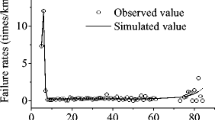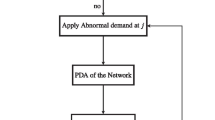Abstract
Integrated management of pipe networks should include methods for monitoring, repairing and replacing deteriorating components (usually pipes), but also methods and everyday operating practices towards a proactive risk assessment approach in order to give a solid answer to the unavoidable “repair or replace” dilemma. The present paper attempts to check whether the Discriminant Analysis and Classification (DAC) method can be used to achieve the above mentioned goals and predict the future behaviour of network pipes. Three pipe networks carrying different types of fluids (oil; gas; and water) are used as case studies. For each case study network, the DAC method is used to classify the pipes into two groups (failures/successes), based on simple variables (pipe/network characteristics) and dimensionless joint ones. Several scenarios are being analysed for each case. The results for the two cases of oil and gas networks are very satisfying. The implementation of the DAC method to water pipe networks needs to overcome serious problems related to the quality, reliability and compatibility of the data records provided by the Water Utilities. In this paper, these shortcomings are faced combining field data with theoretical one. Also the distinction between what “failure” and “success” actually mean in a water pipe network has to be determined. The present study uses the total water volume being lost as a definition criterion.



Similar content being viewed by others
References
Andreou SA, Marks DH, Clark RM (1987) A new methodology for modelling break failure patterns in deteriorating water distribution systems: applications. Adv Water Resour 10(1):11–20. doi:10.1016/0309-1708(87)90003-0
Aslani P (2003) Hazard rate modelling and risk analysis of water mains. MSc Dissertation, Polytechnic University New York
Bakouros Y (1988a) Offshore Pipeline Prediction. PhD Thesis, University of Bradford UK
Bakouros Y (1988b) Predicting pipeline reliability using discriminant analysis. In: Libberton GR (ed) 10th Advances in Reliability Technology Symposium. Elsevier Applied Science
Celik E, Muhammetoglu H (2008) Improving public perception of tap water in Antalya city, Turkey. J Water Supply: Res and Technol—AQUA 57(2):109–113. doi:10.2166/aqua.2008.040
Christodoulou S (2009) Water network assessment and reliability analysis by use of survival analysis. EWRA 7th Conference, Limassol, Cyprus, pp 503–510
Christodoulou S, Aslani P, Vanrenterghem A (2003) A risk analysis framework for evaluating structural degradation of water mains in urban settings, using neurofuzzy systems and statistical modeling techniques. World Water & Environmental Resources Congress 2003 and Related Symposia, Pennsylvania, USA pp 681–689
Christodoulou S, Charalambous C, Adamou A (2007) Managing the “Repair or Replace” dilemma on water leakages. In International Conference on Water Resources Management: New Approaches and Technologies, EWRA (European Water Resources Association). Chania, Crete—Greece
Christodoulou S, Deligianni A (2010) A neurofuzzy decision framework for the management of water distribution networks. Water Resour Manag 24(1):139–156. doi:10.1007/s1126900994412
Christodoulou S, Deligianni A, Aslani P, Agathokleous A (2009) Risk-based asset management of water piping networks using neurofuzzy systems. Comput Env Urban Syst 33(2):138–149. doi:10.1016/j.compenvurbsys.2008.12.001
Clark R, Goodrich J (1989) Developing a data base on infrastructure needs. J Am Water Works Assoc 81(7):81–87
Clark RM, Stafford CL, Goodrich JA (1982) Water distribution systems: a spatial and cost evaluation. J Water Resour Plan Manag 108(3):243–256
De la Mare RF, Anderson O (1980) Pipeline reliability. Det Norske Veritas, Report No. 80–0572
Fisher R (1936) The use of multiple measurements in taxonomic problems. Ann Eugen 7:179–198
Goulter I, Davidson J, Jacobs P (1993) Predicting water-main breakage rates. J Water Resour Plan Manag 119(4):419–436
Goulter I, Kazemi A (1988) Spatial and temporal groupings of water main pipe breakage in Winnipeg. Can J Civ Eng 15(1):91–97
Johnson RA, Wichern DW (2007) Applied multivariate statistical analysis. 6th edition. Pearson International Edition
Kanakoudis V (2004) A troubleshooting manual for handling operational problems in water pipe networks. J Water Supply: Res and Technol—AQUA 53(2):109–124
Kanakoudis V, Tolikas D (2001) The role of leaks and breaks in water networks—technical and economical solutions. J Water Supply: Res and Technol—AQUA 50(5):301–311
Kanakoudis VK, Tolikas DK (2004) Assessing the performance level of a water system. Water Air Soil Pollut: Focus 4(4–5):307–318. doi:10.1023/B:WAFO.0000044807.41719.c7
Kanakoudis V, Tsitsifli S (2007) Reliability assessment and data classification using discriminant functions and factor analysis. In Proc., International Specialist Conference WaterLoss 2007 Volume III pp 837–846
Kettler A, Goulter I (1985) An analysis of pipe breakage in urban water distribution networks. Can J Civ Eng 12(2):286–293
Klecka WR (1980) Discriminant Analysis. Sage University Paper series on Quantitative Applications in the Social Sciences. 07–019. Beverly Hills-London: Sage Publications
Kleiner Y, Adams BJ, Rogers JS (1998) Long-term planning methodology for water distribution system rehabilitation. Water Resour Res 34(8):2039–2051. doi:10.1029/98WR00377
Kleiner Y, Rajani B (1999) Using limited data to assess future needs. J Am Water Works Assoc 91(7):47–62
Levine MS (1977) Canonical Analysis and Factor Comparison. Sage University Paper series on Quantitative Applications in the Social Sciences. 07–06. Beverly Hills-London: Sage Publications
Luksa RA (1980) The Why, What and How of Maintaining System Records. J Am Water Works Assoc pp 496–550
Muhammetoglu A, Muhammetoglu H, Oktas S, Ozgokcen L, Soyupak S (2005) Impact assessment of different management scenarios on water quality of Porsuk River and dam system—Turkey. Water Resour Manag 19(2):199–210. doi:10.1007/s11269-005-3473-z
O’Day DK (1982) Organizing and analyzing leak and break data for making main replacement decisions. J Am Water Works Assoc 74(11):588–594
Park S, Jun H, Kim BJ, Im GC (2008) Modelling of water main failure rates using the log-linear ROCOF and the power law process. Water Resour Manag 22(9):1311–1324. doi:10.1007/s11269-007-9227-3
Prasad TD, Hong SH, Park N (2003) Reliability based design of water distribution networks using multi-objective genetic algorithms. KSCE J Civ Eng 7(3):351–361. doi:10.1007/BF02831784
Shamir U, Howard C (1979) An analytical approach to scheduling pipe replacement. J Am Water Works Assoc 71:248–258
Stourm A (1997) Optimization of reliability prediction using joint variables. MSc Dissertation, University of Thessaly Greece
Tatsuoka MM (1971) Multivariate analysis. Wiley, New York
Tatsuoka M, Tieteman D (1954) Discriminant analysis. Rev Educ Res 24:402–420
Tiryakioglu O, Muhammetoglu A, Muhammetoglu H, Soyupak S (2005) Modeling chlorine decay in drinking water distribution network: case study of Antalya, Turkey. Fresenius Environ Bull 14(10):907–912
Tsitsifli S, Kanakoudis V (2010) Predicting the behavior of a pipe network using the “critical z-score” as its performance indicator. Desalination 250:258–265. doi:10.1016/j.desal.2009.09.042
US Army Corps of Engineers (1980) NY District, NY City Water Supply Infrastructure Study
US Environmental Protection Agency (2006) Decision-support tools for predicting the performance of water distribution and wastewater collection systems. Vol. EPA/600/R-02/029. Washington, D.C. USA, US EPA
Vanrenterghem-Raven A, Eisenbeis P, Juran I, Christodoulou S (2004) Statistical modelling of the structural degradation of an urban water distribution system: Case study of New York City. World Water & Environmental Resources Congress 2003 and Related Symposia, Pennsylvania, USA
Author information
Authors and Affiliations
Corresponding author
Rights and permissions
About this article
Cite this article
Tsitsifli, S., Kanakoudis, V. & Bakouros, I. Pipe Networks Risk Assessment Based on Survival Analysis. Water Resour Manage 25, 3729–3746 (2011). https://doi.org/10.1007/s11269-011-9881-3
Received:
Accepted:
Published:
Issue Date:
DOI: https://doi.org/10.1007/s11269-011-9881-3




